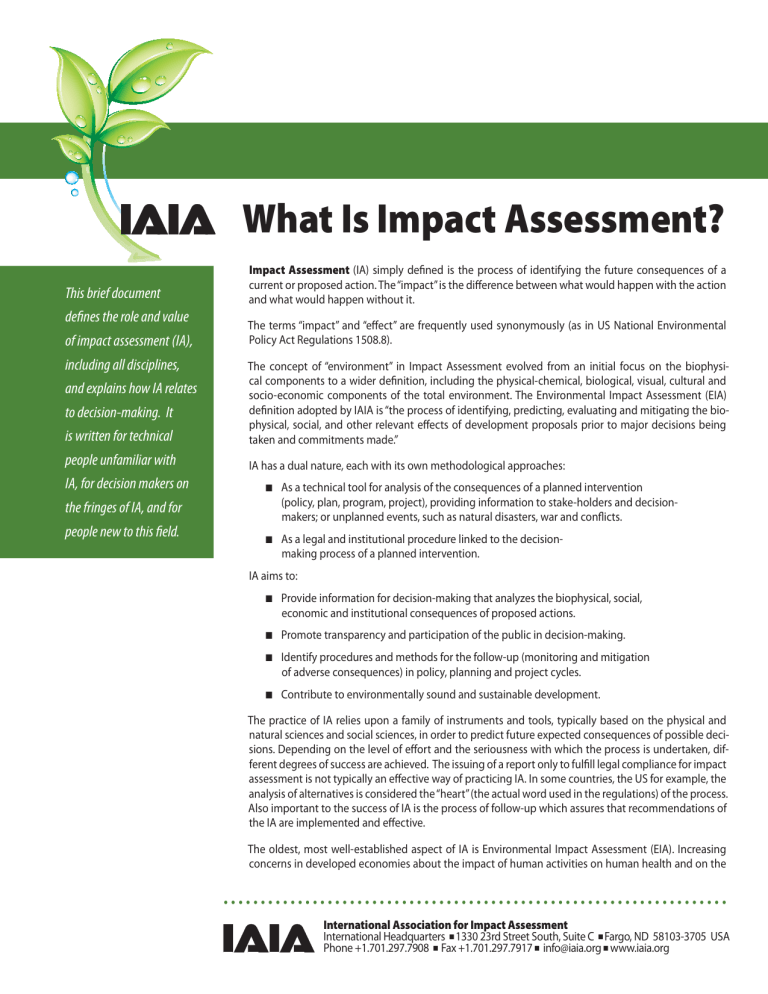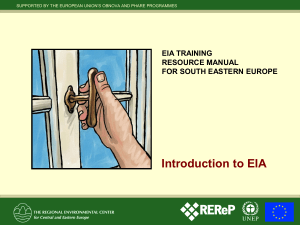What is IA.indd - International Association for Impact Assessment
advertisement

What Is Impact Assessment? This brief document defines the role and value of impact assessment (IA), including all disciplines, Impact Assessment (IA) simply defined is the process of identifying the future consequences of a current or proposed action. The “impact” is the difference between what would happen with the action and what would happen without it. The terms “impact” and “effect” are frequently used synonymously (as in US National Environmental Policy Act Regulations 1508.8). is written for technical The concept of “environment” in Impact Assessment evolved from an initial focus on the biophysical components to a wider definition, including the physical-chemical, biological, visual, cultural and socio-economic components of the total environment. The Environmental Impact Assessment (EIA) definition adopted by IAIA is “the process of identifying, predicting, evaluating and mitigating the biophysical, social, and other relevant effects of development proposals prior to major decisions being taken and commitments made.” people unfamiliar with IA has a dual nature, each with its own methodological approaches: and explains how IA relates to decision-making. It IA, for decision makers on ■ As a technical tool for analysis of the consequences of a planned intervention (policy, plan, program, project), providing information to stake-holders and decisionmakers; or unplanned events, such as natural disasters, war and conflicts. ■ As a legal and institutional procedure linked to the decisionmaking process of a planned intervention. the fringes of IA, and for people new to this field. IA aims to: ■ Provide information for decision-making that analyzes the biophysical, social, economic and institutional consequences of proposed actions. ■ Promote transparency and participation of the public in decision-making. ■ Identify procedures and methods for the follow-up (monitoring and mitigation of adverse consequences) in policy, planning and project cycles. ■ Contribute to environmentally sound and sustainable development. The practice of IA relies upon a family of instruments and tools, typically based on the physical and natural sciences and social sciences, in order to predict future expected consequences of possible decisions. Depending on the level of effort and the seriousness with which the process is undertaken, different degrees of success are achieved. The issuing of a report only to fulfill legal compliance for impact assessment is not typically an effective way of practicing IA. In some countries, the US for example, the analysis of alternatives is considered the “heart” (the actual word used in the regulations) of the process. Also important to the success of IA is the process of follow-up which assures that recommendations of the IA are implemented and effective. The oldest, most well-established aspect of IA is Environmental Impact Assessment (EIA). Increasing concerns in developed economies about the impact of human activities on human health and on the •••••••••••••••••••••••••••••••••••••••••••••••••••••••••••••••••••• International Association for Impact Assessment International Headquarters ■ 1330 23rd Street South, Suite C ■ Fargo, ND 58103-3705 USA Phone +1.701.297.7908 ■ Fax +1.701.297.7917 ■ info@iaia.org ■ www.iaia.org biophysical environment led to the development of the concept of EIA in the 1960s, and to its adoption as a legallybased decision-support instrument later in that decade to assess the environmental implications of proposed development. The National Environmental Policy Act (NEPA) in the USA, which became effective on January 1, 1970, was the first of many EIA laws and procedures in countries around the world. The European Union approved a Directive on EIA in 1985 Currently, EIA is a requirement in most countries of the world. In some countries, there are often both national/ federal and state/regional EIA systems and regulations. Some EIA systems or jurisdictions constrain EIA to the analysis of impacts on the biophysical environment while others include the social and economic impacts of development proposals. Some systems (e.g., African Development Bank) use the expression “Environmental and Social Impact Assessment” to emphasize the inclusion (and the importance) of the social impacts. Other forms of IA focus on specific type of impacts (e.g., Social IA, Health IA, Ecological or Biodiversity IA). These may be carried out independently, but also in a joint exercise with other IA. To emphasize such integration of different forms of impacts, some professionals and institutions use the expression Integrated IA. For others, the integration of the environment, social and economic dimensions of assessment justifies the adoption of a distinct term: Sustainability Assessment. IA types such as SIA and HIA are generally not embedded in a legal framework as is the case for EIA in most countries. Sometimes there is a focus on the context of impacts, e.g., Transboundary IA or Cumulative IA. Depending on the regulatory framework of a particular nation or region, all the substantive issues mentioned here as well as transboundary and cumulative impact issues may be required in the document that is called the EIA. The need to apply IA to strategic levels of decision-making (e.g., policies, legislation, plans, programs) led to the development of Strategic Environmental Assessment (SEA). SEA is generally understood as an impact assessment process that aims to mainstream environmental, social, economic, and health issues and ensure the sustainability of strategic decisions. Legal provisions for SEA are emerging, in many cases associated with EIA institutions and legislation. The European Union approved a directive on the environmental assessment of plans and programs in 2001. The SEA is gaining increasing acceptance as a tool that is used early in decision-making to help inform decisions at the sectoral and regional level and to set the parameters for alternatives analysis. IA in the international arena At the international level, IA was fully recognized in 1992 at the United Nations Conference on Environment and Development, held in Rio de Janeiro. Principle 17 of the Final Declaration is dedicated to EIA: “Environmental impact assessment, as a national instrument, shall be undertaken for proposed activities that are likely to have a significant adverse impact on the environment and are subject to a decision of a competent national authority.” The Millennium Development Goals, adopted by 189 nations and signed by 147 heads of state and governments during the UN Millennium Summit in 2000, provide a framework for the integration of the principles of sustainable development into country policies and programs, which is one of the aims of SEA. Several international conventions have specific requirements for EIA and SEA: the UN Convention on Biological Diversity (Rio de Janeiro, 1992); the UN Convention on the Law of the Seas (Montego Bay, 1982); the regional Convention on EIA in a Transboundary Context (Espoo, 1991), which has a specific Protocol on SEA (Kiev, 2003); and the Antarctic Treaty (Washington, 1959), which has an Environmental Protocol (Madrid, 1991) that institutes an international EIA system for the Antarctic. Other global and regional conventions include provisions for EIA and SEA. These include the Convention on Migratory Species (Bonn, 1979); the Convention for the Protection of the Architectural Heritage of Europe (Granada, ••••••••••••••••••••••••••••••••••••••••••••••••••••••••••••••••••••••••••••••••• PAGE 2 1985); the European Convention on the Protection of the Archaeological Heritage (Revised) (Valletta, 1992); the European Convention on Landscape (Florence, 2000); and the Convention on Access to Information, Public Participation in Decision-making and Access to Justice in Environmental Matters (Aarhus, 1998). Most multi-lateral development banks have developed EIA systems. The first operational directive on EIA at the World Bank dates from 1989. Many multi-lateral institutions have built strong internal procedures, and more recently SEA procedures. As of June 2009, sixty-six financial institutions, including many commercial banks, with operations in over 100 countries have adopted The Equator Principles, making them the project finance industry standard for addressing environmental and social issues in global project finance. The Equator Principles are based on the environmental and social performance standards of the International Finance Corporation (IFC) in order to ensure that the major projects they finance are developed in a manner that is socially responsible and reflect sound environmental management practices. IA is an important tool used by national development assistance institutions to integrate environmental and social issues into development cooperation, as well as addressing public participation and good governance issues. The OECD (Organization for Economic Co-operation and Development) has been active in the coordination work on IA and development assistance. Three key international journals on IA are published, notably Impact Assessment and Project Appraisal (the journal of IAIA), EIA Review (Elsevier) and the Journal of Environmental Assessment, Planning and Management (Imperial College Press). Many practitioners and administrators, coming from backgrounds in the sciences, social sciences, planning, architecture, landscape architecture and business, are practicing IA professionals. Other professionals who are involved in specific phases or parts of IA processes see IA as a planning and management tool rather than as separate professional discipline. In some countries there are certification and accrediting schemes for IA professionals. References See www.iaia.org/resources for Key Citations in Impact Assessment as well as best practice guidelines (www.iaia. org/resources-networking/key-citations.aspx) in the major fields of impact assessment. Web sites International Association for Impact Assessment www.iaia.org The Equator Principles www.equator-principles.com/index.shtml IA as a professional field and a scientific discipline The Millennium Development Goals www.un.org/millenniumgoals/ IA is a key subject of university courses at the undergraduate, graduate and post-graduate levels. These courses are important not only in the natural resource or environmental field, but also in geography, planning, engineering, law, economy, management, public health, and others fields of study. IA is a continuing subject of academic research, generating large numbers of PhD and MSc theses each year in the multiple fields of IA. ••••••••••••••••••••••••••••••••••••••••••••••••••••••••••••••••••••••••••••••••• PAGE 3 About the International Association for Impact Assessment (IAIA) Impact assessment (IA) became the focus of the International Association of Impact Assessment (IAIA), which was founded in 1980, to provide a technical and professional association for those who were working in this emerging field. Since its founding, IAIA has become the leading global network of IA professionals. Each year IAIA organizes an international conference with participation of delegates from governments, international organizations, business, consultants, universities and NGOs. Regional, national and sub-national IA professional associations are active in the five continents, most of which are affiliated with IAIA. IAIA is a forum for advancing innovation, development, and communication of best practice in impact assessment. IAIA views the assessment of all types of impacts as being the most appropriate means of carrying out impact assessment. IAIA’s international membership promotes development of local and global capacity for the application of environmental, social, health and other forms of assessment in which sound science and full public participation provide a foundation for equitable and sustainable development. IAIA has approved a professional code of conduct and a code of ethics (www.iaia.org) and publishes best practice principles in IA related subjects. IAIA has published and is developing standards for IA professionals to be used by national certification bodies. www.iaia.org •••••••••••••••••••••••••••••••••••••••••• PAGE 4 Document preparation coordinated by Júlio de Jesus, ECOSSISTEMA, Portugal IAIA\Publications\What Is IA.indd (October 2009)


